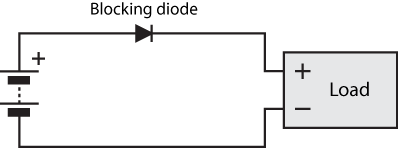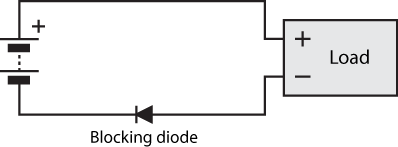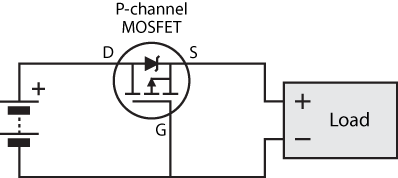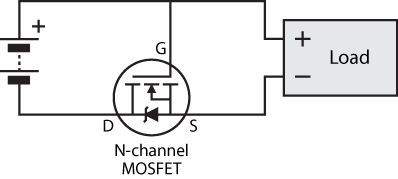Connecting a battery backwards to an electronic circuit can rapidly do a lot of damage — current will flood through (and destroy) many integrated circuits when powered up the wrong way, and electrolytic capacitors have a famous tendency to explode. For this reason, it’s common to use a blocking diode in a circuit to provide reverse polarity protection:

If the battery is connected correctly, as shown, current flows through the diode to the circuit, and the circuit operates normally. If the battery is reversed, the battery tries to pull current through the diode the wrong way, and the diode refuses to conduct — protecting the load from damage.
The diode can also be placed on the low rail, as shown below. This is completely equivalent to the circuit shown above for battery-powered applications. However, it may make less sense in circuit provided positive DC power by an external supply, where having a consistent ground can be important. On the flip side, a circuit that operates using negative DC power (which is much rarer) would be much better off with the circuit below for the same reason.

This blocking diode approach works great for many applications. However, when the diode is conducting, there is a voltage drop across it (typically around 0.7V for silicon diodes, 0.2V for Schottky diodes) which means that the load sees a bit less voltage across it. This is a particularly major problem for low voltage applications, where a 0.3V drop can represent almost 10% of a 3.3V system’s power, wasted at the very first component. For higher power applications, a fair bit of power can be wasted as heat in the diode as well.
An alternative solution: MOSFETs
The wonderful thing about MOSFETs is that they can be designed to have incredibly low voltage drops, which translates into less waste heat and more voltage for the load to operate. You can routinely get MOSFETs with resistances of 20 milliohms and below, which translates to allowing 5 amps to pass with a drop of only 0.1V, less than any diode.
You can’t just use them as a direct drop-in replacement, though, because you have to drive the gate of the MOSFET somehow. Here’s the trick: you can just use the other terminal of the battery for this:

So, how does this work? I’m going to define the voltage of the bottom net, to be ground, the voltage of the battery will be 9V, and the theshold gate voltage of the FET will be –4V. You can see a diode drawn as part fo the symbol for the MOSFET — that’s known as the body diode. Before the battery is connected,
and
will both be zero as well.
At the instant that the battery is connected, will rise to 9V. Before the body diode begins to conduct,
will remain at zero as well. This means that
will be zero, so the FET will still be switched off.
It turns out that this design actually relies on the body diode to work, at least briefly. Current will flow through the body diode to the load, raising to 7V or so (body diodes don’t tend to have the best forward voltage drops). This brings
to –7V, which goes well beyond the threshold voltage and will turn the FET on. At this point,
will rise to 9V (minus the small voltage drop across the FET).
When reverse biased, the body diode will be reverse biased, and will therefore not conduct. will be somewhere between 0V and +9V, that is to say, somewhere between off and very off. So the FET performs its blocking duties admirably.
An N-channel FET can be used on the bottom rail instead, like so:

The same comments apply as for the aforementioned blocking diode on the bottom rail. There’s one additional advantage here, though: N-channel FETs tend to have better performance characteristics than P-channel FETs (although these days, both are remarkably excellent).
What’s the catch?
There are a number of reasons why this MOSFET circuit is not always a suitable replacement for a normal blocking diode:
- Some blocking diodes are used in applications where current from a generator is used to charge two separate batteries. If one battery ends up with a higher voltage than another, the blocking diodes prevent electricity from flowing out of the higher voltage battery, back onto the generator leads, and into the other battery. The circuit above will completely fail at this job, because
will be across the battery leads, meaning the the FETs will just permanently be switched on at all times. This is a circuit to prevent the load from becoming reverse biased, not to prevent current escaping the load the wrong way.
- It might not always be easy to physically connect the gate of the MOSFET to the opposite rail, especially with a circuit laid out with a normal diode in mind.
- MOSFETs have a few more maximum limits to check and look after than diode, owing mostly to the fact the a MOSFET has an extra leg. This isn’t a practical disadvantage, just something to be careful about.
Is it safe to pass current through the MOSFET in the non-conventional direction?
It might seem unusual to pass current up through the MOSFET, especially since the curves in datasheets don’t seem to cover this region. However, operation in this so-called third quadrant is routinely used in buck converters, where a MOSFET is used to replace the reverse recovery diode (source). The reasons for replacing the reverse recovery diode with a MOSFET are exactly the same as for replacing blocking diodes — it’s to avoid energy wasted due to diode voltage drop.
MOSFET selection
The figures below are for the P-FET design, N-FET design will be similar except with a few minus signs thrown around the place. This is just a rough guide, etc.
- The absolute maximum
should be at least
, where
is the voltage of the power supply/battery. This is because in a situation when correct polarity rapidly switches to reverse polarity, you get
,
.
- The absolute maximum
should be at least
.
- Check the output characteristics to ensure that the FET is thoroughly on when
. Roughly speaking, this corresponds to
being greater than than
(remembering, e.g., –2 is greater than –9).
- And of course, check that the FET can handle the current, the power dissipated, and the heat generated. And yes, these are three related but very different things that need to be checked independently (the last is calculated using thermal resistance, given in the datasheet).
Fin.
So there you have it. If anyone out there uses this circuit because of this page, I’d love to hear about it! And as always, I will attend to any questions left below.

Gijs
/ August 13, 2013Hi, thanks mate, helped me a lot in my smps design. Was wondering though, should “The absolute maximum Vds should be at least +-Vds” be “The absolute maximum Vds should be at least +-Vgs”?
Gijs
/ August 13, 2013Scratch that… I meant: “The absolute maximum Vgs should be at least +-Vbat”. Lolself.
Robert
/ August 13, 2013Yep, thanks for pointing that out! Now fixed. I’d be keen to see your design!
Mrinal Mani
/ November 1, 2013Thanks a lot! Wonderfully written…
James Clark
/ July 31, 2014Really useful thorough explanation. Using in a project now. Thanks
kin
/ February 1, 2015can i use p-channel mosfet protecting my battery from reverse voltage coming out my dc motor generator?
Robert
/ February 1, 2015No, the battery’s voltage will hold the MOSFET on, even if a backwards generator is sucking charge out of the battery.
Hamza Mahmood
/ September 12, 2018Can we put the N channel on the upper rail, just like we realized a simple diode can be put on either rail. i.e, source to +ve battery, Drain to load, Gate to bottom rail. I want a ~0.5V drop AND blocking characteristics
Robert
/ September 12, 2018That wouldn’t do anything useful. The body diode would be pointing the wrong way, and an N-channel MOSFET is turned on when Vgs is above a certain *positive* theshold voltage; I.e., when the bottom rail is above (+ve battery) + threshold voltage. This will not happen when the power supply is connected correctly, so the MOSFET will not turn on when the power supply is connected correctly.
In fact, the circuit you describe is the same as the N-channel circuit I showed, except upside down. So your described circuit would only allow current to flow when the power source was connected the *wrong* way; doing so very efficiently.
In summary, your suggested arrangement allows current to flow when it shouldn’t, and vice versa.
George
/ March 27, 2020Hi Robert,
thanks for this very nice and descent article.
I have a battery (13-17V) driven device and I want to power the device either by battery or by charger. Now my “blocking diode”, that prevents the permanent on shall be between charger/device (+) and battery (+) with anode a charger/device (+). The power on switch that allows battery operation will just shorten the diode, providing battery + to device +.
Can the diode be replaced by MOSFET switch type P-Channel with body diode kathode at battery +?
William
/ September 23, 2020Thank you for this.
Scott
/ December 3, 2020Thanks, nice write up! I was looking for an explanation of using the MOSFET’s body diode in the reverse direction. This is used as part of a power multiplexer in Microchip’s SAME54 Xplained dev board.